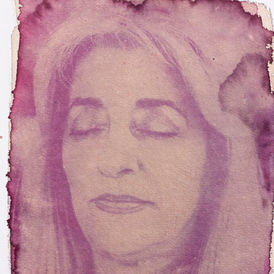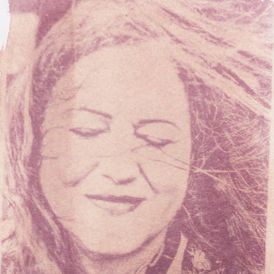"But why not just kill the photo, there and then?”
“Because she might want to look at it again. Because it meant something to her.
Something?
A Great deal?
Everything?"
Penelope Lively, The Photograph (2003).
Below are examples from the anthotype series, which currently includes 200 portraits in varying sizes (A4, A5, A6, and square). All are developed on cotton Khadi paper. Documenting this work through digital photography and sharing it online has been a necessary compromise, one that contradicts my initial intention to remain within the analogue sphere. These digital meta-images—photos of the photos—reflect my inability to fully commit to the ephemerality that the anthotype process inherently offers. I remain captivated by the act of an image’s gradual disappearance, its "death," yet I continue to grapple with how to embrace this inevitable loss.
Someone once asked me, “Why put so much effort into something that won’t last?” My response was that this very ephemerality may teach me to let go of the preciousness often attached to art. This is my greatest challenge: resisting the temptation of sentimentalism, which sometimes manifests as an attachment akin to Gollum’s fixation on his “precious.” Beneath this tendency lies a desire to share something honest and meaningful—an expression born from the encounter between two individuals, making it inherently valuable and worth making accessible to others.
The images, accompanying text, and any additional outputs from this project are intended to be seen as an integral, collective body of work. They are complementary fragments of a shared experience.
Why Document the Anthotypes Digitally?
The decision to digitally document and share these anthotypes arose from three primary motivations:
-
Sharing the Work
I want this project, and the outcomes it generates, to reach a wider community, including those who participated in the process. By sharing, the work gains opportunities to grow, evolve, dissolve, and transform, blurring the boundaries of authorship and ownership. It becomes part of a larger dialogue. -
Practical Limitations
Each anthotype requires days or even weeks to develop. The cost of paper and the limited availability of flowers make it impractical to produce multiple copies for participants. Sending them even a single copy remains a long-term goal, but current resources restrict this possibility. -
Irreplaceable Physicality
Digital images cannot replicate the experience of holding an anthotype. The texture of the cotton Khadi paper, its subtle scent, and the delicate shades of color that fade slightly with each exposure to light—all these qualities are intrinsic to the original artifact. These are sensations and nuances that cannot be reproduced or fully conveyed through digital documentation. Holding an anthotype is a singular experience. Each piece is a unique, ephemeral object that resists replication. It invites a personal encounter and new conversations depending on the theoretical lens one applies to the work. -
Embracing Play and Creation
While the project raises profound questions about control, impermanence, and authorship, it also celebrates the joy of making and playing without over-analysis. This balance between introspection and creative spontaneity is something I strive to honor.



























